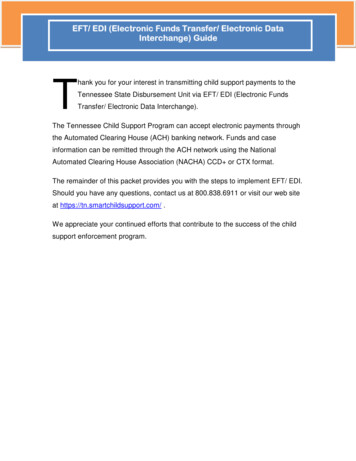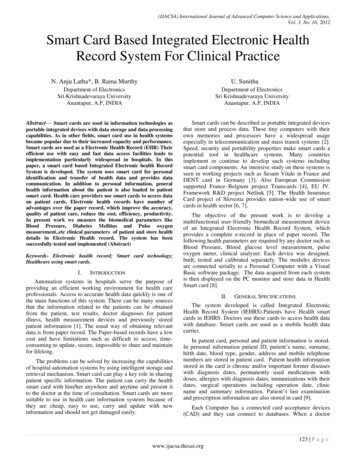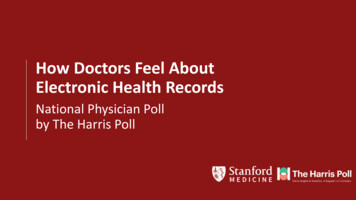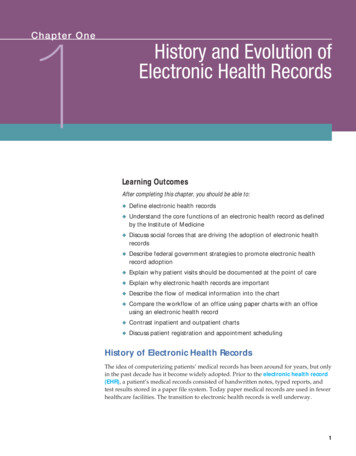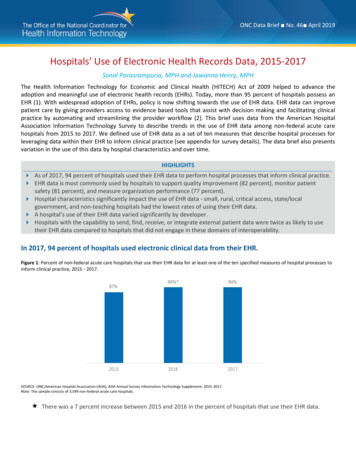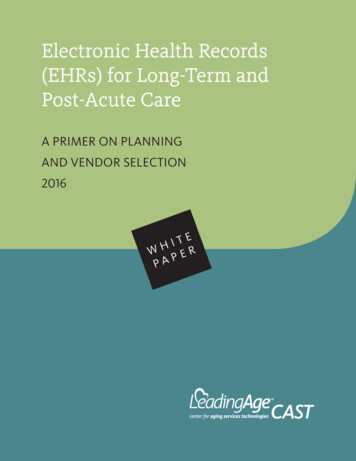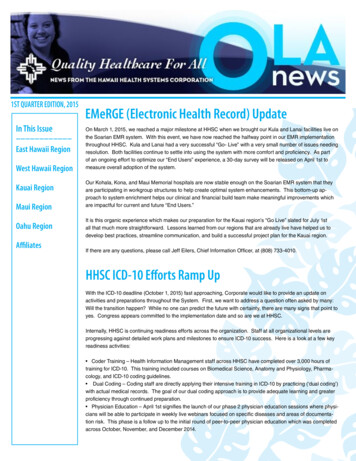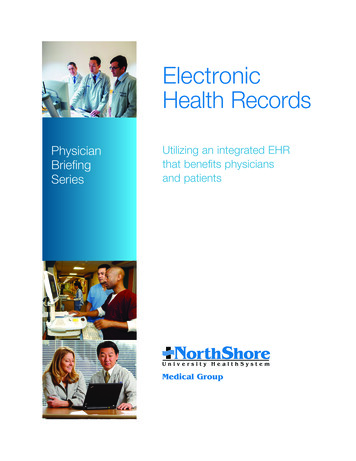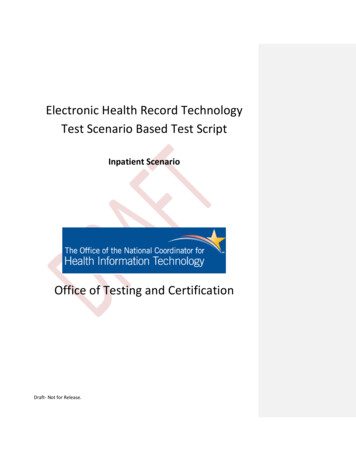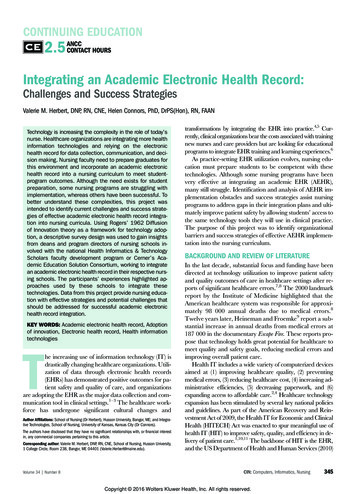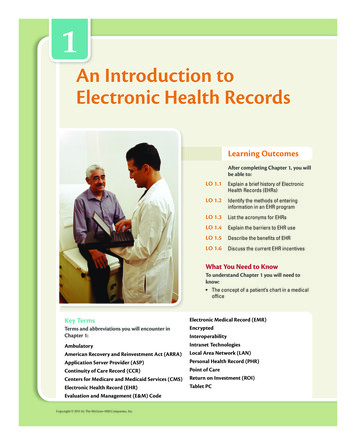
Transcription
CONFIRMING PAGES1An Introduction toElectronic Health RecordsLearning OutcomesAfter completing Chapter 1, you willbe able to:LO 1.1Explain a brief history of ElectronicHealth Records (EHRs)LO 1.2Identify the methods of enteringinformation in an EHR programLO 1.3List the acronyms for EHRsLO 1.4Explain the barriers to EHR useLO 1.5Describe the benefits of EHRLO 1.6Discuss the current EHR incentivesWhat You Need to KnowTo understand Chapter 1 you will need toknow: The concept of a patient’s chart in a medicalofficeKey TermsTerms and abbreviations you will encounter inChapter 1:AmbulatoryAmerican Recovery and Reinvestment Act (ARRA)Application Server Provider (ASP)Continuity of Care Record (CCR)Centers for Medicare and Medicaid Services (CMS)Electronic Health Record (EHR)Evaluation and Management (E&M) CodeElectronic Medical Record (EMR)EncryptedInteroperabilityIntranet TechnologiesLocal Area Network (LAN)Personal Health Record (PHR)Point of CareReturn on Investment (ROI)Tablet PCCopyright 2011 by The McGraw-Hill Companies, Inc.ham74393 ch01 001-015.indd 112/9/09 1:18:26 PM
CONFIRMING PAGES2Chapter OneLO 1.1 THE ELECTRONIC HEALTH RECORD HISTORYFocal PointImprovement to the qualityof patient medical careand safety has alwaysbeen the catalyst forthe development of theelectronic health recordconcept.Electronic HealthRecord (EHR)Electronic health recordsis the most commonlyaccepted term forsoftware with a full rangeof functionalities to store,access, and use patient medical information.The concept of a patient’s medical information stored electronically instead ofon paper is not a new one. In the 1960s, as medical care became more complex,doctors realized that in certain situations the patient’s complete health historywould not be accessible to them. The availability of comprehensive medicalinformation when needed brought the innovation of storing the patient’s information electronically. Improvement of patient medical care was and is thecatalyst for the electronic health record (EHR).The Mayo Clinic in Rochester, Minnesota, and the Medical Center Hospitalof Vermont were some of the first clinics to utilize an electronic medical recordsystem. Their systems were developed in the early 1960s. Over the next two decades, more information and functionalities were added to the electronic medicalrecord system in order to improve patient care. Drug dosages, side effects, allergies, and drug interactions became available electronically to doctors, enablingthat information to be incorporated into electronic health-care systems. Electronicdiagnostic and treatment plans, which gave doctors information for patient care,proliferated and were integrated into electronic medical record systems. Moreacademic and research institutes developed their own computerized medicalrecord systems as tools to track patient treatment. Overall, the utilization andgrowth of these computer models was to increase the quality of patient care.LO 1.2 METHODS OF DATA ENTRYPoint of CarePoint of care is the time andplace of care being given tothe patient from the healthcare provider.Tablet PCA portable, handheldcomputer with the ability todocument directly on thescreen with a stylus pen.Local Area Network(LAN)A wired and/or wirelessconnection of computers ona single campus or facility.As computer technology continues to rapidly develop, the versatility of theEHR becomes greater. Access through the EHR to patient information, medical alerts, warnings, drug information, and disease management is now at thepoint of care for the health-care provider in a more user-friendly form. Modesof data entry into the EHR have progressed. Traditionally, a keyboard was theonly source for data entry. However, the need for convenience, efficiency, andspeed has mandated other methods. Voice recognition systems adapt to a person’s voice and speech patterns so that the computer inputs data as the operator speaks. Electronic handwriting recognition is also now available. These twomethods of data input are not commonly used because they require that theuser repeat the same activity each time the data is needed. More commonly,large bodies of preset text known as “templates” can be easily selected to inputinto the patient’s record. Instead of significant amounts of typing, health-careproviders can enter data and access data through a few taps of a stylus pen on atouch screen or the click of a mouse. Touch screens are utilized on such devicesas a Notebook Tablet or a Tablet PC, making the EHR portable and accessible foreasy data entry. The ease of use and speed of the “Tap&Go” feature with theTablet PC has made EHRs more desirable. Traditionally, a stationary computerworkstation in each exam room has been cost-prohibitive for the independentphysician, or a desktop computer may not be available at the point of care,resulting in delayed data entry, thus patient information is not readily available to other physicians and medical support staff. However, in recent yearsthe increased use of laptops, Tablet PCs, and wireless connectivity has broughtgreater mobility and lower costs to the health-care provider.Networks have advanced in security and reliability to enable both flexibility and mobility of the EHR. A Local Area Network (LAN) enables computers to communicate together and utilize a main server for the database. TheLAN system is very customizable, according to the office needs. This networksystem may consist of wired connections and/or utilize a wireless network asCopyright 2011 by The McGraw-Hill Companies, Inc.ham74393 ch01 001-015.indd 212/9/09 1:18:43 PM
CONFIRMING PAGES3An Introduction to Electronic Health RecordsInternet via DSL, cable, orother broadband connectionBroadbandRouterWirelessFocal PointPC #1PC #2LaptopTablet PCFigure 1.1 Hardwired and wireless LAN system.illustrated in Figure 1.1. The wireless LAN networks enable health-care providers full or open access to their EHRs from anywhere within their office.Internet and intranet technologies have increased the availability of medicaldatabases that can be shared and accessed across large distances. This remoteaccess gives health-care providers entrance to their EHR from such remote locations as nursing homes, a home office, or hospitals through an Internet connection. These networks are secure and access is limited. Data flowing on thenetwork is also encrypted for security.Another network option for a medical practice is the web-based EHR orApplication Server Provider (ASP). The EHR is accessed by the health-careprovider via the Internet. In this model, the medical practice does not house thesoftware on a computer server at the medical office. Maintenance, updates, andbackups are conducted remotely by the EHR web-hosting company. High-speedCCConcept Checkup 1.1 (LO 1.1, LO 1.2)The affordability of bothhardware and software,and the reliability ofintranet technology andwireless connectivityhave enabled manyindependent physicians totake advantage of the EHRin recent years.Intranet TechnologiesIntranet technology is a privately maintained computernetwork that provides secureaccessibility to authorizedpersons, especially membersor employees of an organization, enabling the sharing ofsoftware, database,and files.EncryptedA.was the initial reason, and continues to be the reason, for thedevelopment of electronic health records (EHRs).B. Several modes of data entry into the EHR programs exist. Some ofthese methods of data entry are:1.When computer data ischanged from its originalform to be transmittedsecurely so as to be unintelligible to unauthorized partiesand then decrypted backinto its original form for use.2.3.4.C. What two types of technologies have increased the availability ofmedical databases and access to the EHR?1.2.Application ServerProvider (ASP)This enables a doctor’s officeto access an EHR via theInternet, whereas the EHRsoftware and database arehoused and maintained bya separate company in aremote location.Copyright 2011 by The McGraw-Hill Companies, Inc.ham74393 ch01 001-015.indd 312/9/09 11:49:16 PM
CONFIRMING PAGES4Chapter OneInternet connectivity is required in this situation. However, concerns can be thesecurity of the EHR, the speed of downloading and uploading images or largefiles, and ensuring that the Internet connectivity is always available.1LO 1.3 ACRONYM ALPHABET SOUPAn alphabet soup of acronyms surrounds electronic health records (EHRs).Some of these definitions have been flexible and reveal an evolution of termsand meanings to government agencies and independent associations influencing the field of electronic health records. The differences are not just semantics;the terms have evolved with more and more distinct definitions. They disclosesome of the history in the progression of the electronic health record. However,although the following terms and meanings are supplied to help with clarity,the various acronyms can all still be used to describe the concept of an electronichealth record.Electronic MedicalRecord (EMR)The term for software thatlacks a full range of higherend functionalities to store,access, and use patient medical information.InteroperabilityInteroperability is the ability of a software program toaccept, send, or communicate data from its databaseto other software programsfrom multiple vendors.Continuity of CareRecord (CCR)A core set of provideroriented health data reflecting the most relevant andtimely facts about a patient’shealth care. It is vendor andtechnology neutral, enablingthe access of patient information between health-careproviders.EHR - Electronic Health Record: Currently, this term is the most commonly accepted and used term for storing and accessing patient medicalinformation electronically. EHR encompasses a full range of functionalitiesand information including patient demographics, progress notes, problems,medications, vital signs, past medical history, immunizations, laboratorydata, radiology reports, scheduling, transcription, e-prescribing, evaluationand management (office visit level) coding, care alerts, chief complaints,evidence-based decision support, and health maintenance. In the future, anEHR will include a continuity of care record (CCR) and the personal healthrecord (PHR); standards for these functionalities are still being developed.EMR - Electronic Medical Record: This term was widely used as the termsmigrated away from the computer-based patient record. As definition ofterms became clearer, EMR came in second to the fully functional EHR. AnEMR does not offer certain high-end functionalities such as health maintenance and disease management, care alerts, the CCR (continuity of carerecord), personal health record functions, or interconnectivity with providers outside the practice.CPR - Computer-Based Patient Record: This term was one of the first used toconceptualize the idea of an EHR. A computerized patient record is a lifetimepatient record that includes all information from all specialties (even dentistryand psychiatry) and is available to all providers (potentially internationally).Because the CPR requires full interoperability between EHRs, the CPR is notrealistic in the foreseeable future. In the early 1990s there was an initiative touse the CPR; however, the concept evolved into the EMR and EHR.EPR - Electronic Patient Record: EPR is similar to the CPR but does notnecessarily contain a patient’s lifetime record and does not include dental,behavioral, or alternative care. It focuses on the patient’s relevant medicalinformation.CCR - Continuity of Care Record: The CCR is health-provider-orientedand defines a core set of data reflecting the most relevant and timely factsabout a patient’s health care. The CCR would be a subset of the EHR. Typically it includes patient information, diagnoses, recent procedures, allergies,medications, and future treatment plans. It should be accessible to all careproviders whenever needed. The electronic CCR is designed to be vendorand technology neutral, that is, accessible and readable by other electronicsystems. The CCR should be updated by the practitioner at the close of aCopyright 2011 by The McGraw-Hill Companies, Inc.ham74393 ch01 001-015.indd 412/9/09 1:18:43 PM
CONFIRMING PAGES5An Introduction to Electronic Health Recordspatient encounter or upon the transfer of data from one caregiver to another,whether inpatient-, outpatient-, or community-based.PHR - Personal Health Record: The PHR allows the patient to become aninteractive source of health information and health management throughan Internet-based connection to the practice website. Through a secure connection, patients may schedule appointments, request medication refills,access lab or radiology results, and ask questions about their health. SomePHRs enable patients to complete or update family or social histories oreven read their medical records and notify providers of incorrect or missinginformation.CCPersonal Health Record(PHR)PHRs allow the patientaccess via the Internetto store and update personal medical informationand make inquires to thepatient’s health-care providerabout prescriptions, appointments, or concerns.Concept Checkup 1.2 (LO 1.3)A. What is most commonly accepted term for storing and accessingpatient medical information electronically?B. What term was one of the first used to conceptualize the idea of anelectronic health record (EHR)?LO 1.4 BARRIERS TO THE EHRAlthough Electronic Health Records (EHRs) bring tremendous benefits to patient care and to the health-care provider, use of the ambulatory EHR insteadof the paper chart did not become widespread among the independent physicians during the 1990s. Even though the motivation of improved patient careand availability of medical data was present, health-care providers were hesitant to begin using this medical tool. Specific reasons have been hypothesizedfor the lack of EHR implementation, and they are outlined below.A Lack of Standards for EHR SystemsThe content within the systems did
Electronic health records is the most commonly accepted term for software with a full range of functionalities to store, access, and use patient medi-cal information. Point of Care Point of care is the time and place of care being given to the patient from the health-care provider. Tablet PC A portable, handheld computer with the ability to document directly on the screen with a stylus pen .

